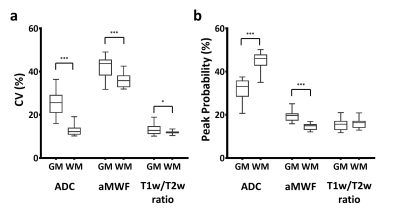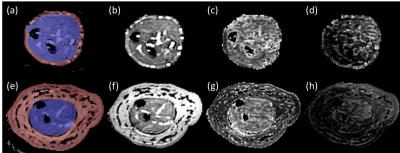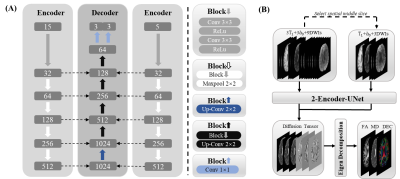Online Gather.town Pitches
Diffusion & Susceptibility II
Joint Annual Meeting ISMRM-ESMRMB & ISMRT 31st Annual Meeting • 07-12 May 2022 • London, UK

| Booth # | ||||
|---|---|---|---|---|
4718 |
1 | A self-supervised deep learning approach for quantitative susceptibility mapping without ground truth labels
Ming Zhang1, Jie Feng1, and Hongjiang Wei1
1School of Biomedical Engineering, Shanghai Jiao Tong University, Shanghai, China
Supervised deep learning methods for QSM reconstruction from tissue phase mainly rely on the ground truth susceptibility maps for training, which are not available for QSM. To address this issue, we propose a self-supervised deep learning method, TKD2TKD, for susceptibility reconstruction using artifact-contaminated TKD-TKD pairs acquired at different head orientations of one subject. The primary motivation of TKD2TKD is that the average of the network gradients by feeding TKD pairs will converge to the true gradient of that trained with high-quality averaged TKD images. The preliminary results suggested that TKD2TKD performed well in QSM reconstruction with improved susceptibility quantification accuracy.
|
||
4719 |
2 | An improved asymmetric susceptibility tensor imaging model with frequency offset correction
Ruimin Feng1, Steven Cao2, Chunlei Liu2, and Hongjiang Wei1
1Biomedical Engineering, School of Biomedical Engineering, Shanghai Jiao Tong University, Shanghai, China, 2Department of Electrical Engineering and Computer Sciences, University of California, Berkeley, CA, United States
The existing reconstruction methods for susceptibility tensor imaging assume that frequency shifts are purely from magnetic susceptibility effects, which may result in noise and error propagation in the calculated susceptibility quantities. In this study, we proposed an extended asymmetric susceptibility tensor model that introduced the non-susceptibility-induced frequency shift, i.e. offset term. Simulation, ex vivo, and in vivo data were reconstructed using the proposed model and compared models. Experimental results show that the proposed method leads to more discernable fiber structures and more accurate fiber orientation estimation. This study inspires STI reconstruction from the perspective of better modeling frequency sources.
|
||
4720 |
3 | Preliminary Assessment of Intravoxel Incoherent Motion Diffusion-Weighted MRI (IVIM-DWI) Metrics in Normal Brain Tissue
Fan Yu1, Qiuxuan Li1, Cheng Zhao1, Mo Zhang1, Liangjie Lin2, Jiazheng Wang2, and Jie Lu1
1Radiology and Nuclear medicine, Xuanwu Hospital, Capital Medical University, Beijing, China, 2Philips Healthcare, Beijing, China, Beijing, China
The microstructure and micro-perfusion changes in normal brain aging is barely understand. The objective of this study is to describe these microscopic changes in normal brain tissue by intravoxel incoherent motion diffusion-weighted MRI (IVIM-DWI). Preliminary results show decreased D, D* and increased f in elder subjects compare with the youngers.
|
||
4721 |
4 | Differential association of apparent diffusion coefficient, apparent myelin water fraction, and T1w/T2w ratio in white matter and grey matter
Nan-Hao Chen1, Li-Ping Chen2, Chia-Wei Hsu2, Chin-Hua Yang1,2,3, and Hsu-Hsia Peng1
1Department of Biomedical Engineering and Environmental Sciences, National Tsing Hua University, Hsinchu, Taiwan, 2National Taiwan University Hospital Hsinchu Branch, Hsinchu, Taiwan, 3Taoyuan General Hospital, Ministry of Health and Welfare, Taoyuan, Taiwan
The purpose of this study was to evaluate the differential associations among various myelin-related indices in white matter (WM) and grey matter (GM) to comprehend the alteration of microstructural integrity in brain tissue. We calculated mean, coefficient of variance (CV), and peak probability of ADC, apparent myelin water fraction (aMWF), and T1w/T2w ratio and found differential associations among myelin-related indices in GM and WM. In conclusion, measurements of ADC, aMWF, and T1w/T2w ratio as well as their correlations can help to understand characteristics of microstructural tissue integrity in GM and WM.
|
||
4722 |
5 | Diffusion Time Dependence of SANDI Analysis using High Gradient Diffusion MRI Data
Tanxin Dong1, Jie Song2, Hong-Hsi Lee3, Qiyuan Tian4,5, Susie Y. Huang4,5,6, and Qiuyun Fan4,5,7
1Department of Intelligent Medical Engineering, Medical College, Tianjin University, Tianjin, China, 2Department of Network and Information, Tianjin Huanhu Hospital, Tianjin, China, 3Massachusetts General Hospital, Charlestown, MA, United States, 4Athinoula A. Martinos Center for Biomedical Imaging, Department of Radiology, Massachusetts General Hospital, Charlestown, MA, United States, 5Harvard Medical School, Boston, MA, United States, 6Harvard-MIT Division of Health Sciences and Technology, Massachusetts Institute of Technology, Cambridge, MA, United States, 7Department of Biomedical Engineering, College of Precision Instruments and Optoelectronics Engineering, Tianjin University, Tianjin, China
High gradient diffusion MRI has recently been demonstrated to be useful in mapping gray matter microstructure, despite of a few caveats arising from the challenges in comprehensively modeling the complex tissue environments. One example was the assumption of impermeable membranes in the SANDI model and hence its limitation in the presence of water exchange depending on the diffusion time (Δ) used in the MR experiments. We found time-dependence in the signal decay in cortical regions for Δ=19ms~49ms, suggesting fast exchange effects, which might be the cause of the observed time-dependence of the fitting parameters using the standard SANDI model.
|
||
4723 |
6 | Time-dependent Diffusion in Extra-Axial Brain Tumors Investigated with Oscillating-gradient Spin-echo. Video Permission Withheld
Tomoko Maekawa1, Masaaki Hori1,2, Katsutoshi Murata3, Thorsten Feiweier4, Kouhei Kamiya1,2, Christina Andica1, Akifumi Hagiwara1, Shohei Fujita1,5, Koji Kamagata1, Akihiko Wada1, and Shigeki Aoki1
1Radiology, Juntendo University School of Medicine, Tokyo, Japan, 2Radiology, Toho University Omori Medical Center, Tokyo, Japan, 3Siemens Healthcare K.K., Tokyo, Japan, 4Siemens Healthcare GmbH, Erlangen, Germany, 5Radiology, Graduate School of Medicine, The University of Tokyo, Tokyo, Japan
The purpose of our study was to investigate the utility of changes in diffusivity between short and long effective diffusion times (Δeff) in distinguishing extra-axial brain tumors. Patients with 12 meningiomas, 13 acoustic neuromas, and 11 pituitary adenomas were undergoing diffusion-weighted imaging with Δeff of 6.5 ms and 35.2 ms. The dependence of λ1, λ2, λ3, and MD values on Δeff was stronger in pituitary adenomas than in meningiomas and acoustic neuroma, suggesting differences in internal tissue structure. Our results showed that the use of DTI with shorter Δeff provides additional information about the microstructure of brain tumors.
|
||
4724 |
7 | To Evaluate Values of Six Cancer-Related DWI Models in Predicting the Levels of HER-2 Expression in Invasive Ductal Carcinoma of the Breast
Cece Dong1, Qian Xu1, Haiyun Wang1, Gaofeng Shi1, Qinglei Shi2, Xu Yan2, and Guang Yang3
1Department of CTMRI, The Fourth Hospital of Hebei Medical University, Shijiazhuang, China, 2MR Scientific Marketing, Siemens Healthineers, Beijing, China, 3Shanghai Key Laboratory of Magnetic Resonance, East China Normal University, Shanghai, China
In this study, we evaluated and compared the values of quantitative parameters derived from the six DWI models in the diagnosis of HER-2 expression levels in patients with IDC of the breast, including conventional mono-exponential model, IVIM, DKI, SEM, FROC, and CTRW models. We found that the CTRW model showed higher sensitivity in the predicting HER-2 expression levels than the other models. Meanwhile, a logistic regression model was built by combining parameters of the advanced DWI models, which showed a high diagnostic performance and may potentially be used in clinical practice.
|
||
4725 |
8 | Exploring the AE model in predicting the prognosis of chemo-radiotherapy for cervical cancer based on clinical and radiomics’ features
Miao Liu1, Qi Wang1, Gaofeng Shi1, Li Yang1, and Qinglei Shi2
1The Fourth Hospital of Hebei Medical University, Shi Jiazhuang, China, 2MR Scientific Marketing , Siemens Healthineers Ltd., Beijing, China
In this study, through optimizing data enhancement, data normalization, dimension reduction and feature screening schemes, an auto encoder (AE) based on clinical and radiomics features of ADC map was established and demonstrated high value in predicting the prognosis of locally advanced cervical cancer LACC in concurrent chemo-radiotherapy.
|
||
4726 |
9 | Characterizing diffusion properties on extremities of patients with lymphedema by MRI
Yeefan Lee1,2, Kuan-Hung Cho3, Chih-Hsing Tang2, Chia-Wen Chiang3, Shih-Yen Lin4, Chen-Hsiang Kuan5, Chien-Yuan Lin6, Hsiao-Ling Lee6, and Li-Wei Kuo3
1Department of Medical Imaging, National Taiwan University Hospital, Taipei, Taiwan, 2Department of Medical imaging, National Taiwan University Hospital Hsin-Chu Branch, Hsin-Chu, Taiwan, 3Institute of Biomedical Engineering and Nanomedicine, National Health Research Institutes, Miaoli County, Taiwan, 4Department of Computer Science, National Yang Ming Chiao Tung University, Hsinchu, Taiwan, 5Department of Surgery, National Taiwan University Hospital, Taipei, Taiwan, 6GE Healthcare, Taipei, Taiwan
Lymphedema is defined as accumulation of fluid and fibroadipose tissues due to disruption of lymphatic flow. Our results demonstrate a significant difference of diffusion measures between lymphedema and normal groups. DKI and DTI derivatives have similar tendency when comparing lymphedema patients with healthy subjects. The diffusion properties may aid the diagnosis of lymphedema and have the potential for evaluating the severity in postoperative follow-up.
|
||
4727 |
10 | Multi-shot multi-b-value diffusion-weighted imaging using EPI with keyhole and locally low-rank reconstruction
Xin Tang1 and Chenxi Hu1
1The Institute of Medical Imaging Technology, School of Biomedical Engineering, Shanghai Jiao Tong University (SJTU), Shanghai, China A multi-b-value DWI imaging method based on multi-shot EPIK with continuously changing b values and Locally Low-Rank (LLR) constraint is proposed. The multi-shot EPIK acquisition improves resolution of multi-b-value DWI, and acquisition of the central k-space in every b-value bypasses the need for careful initialization. The LLR constrained problem is solved by a newly developed ADMM algorithm with robust performance. Preliminary data in healthy subjects showed that the proposed method outperforms LLR-POCS and SPA-LLR for reconstruction at high undersampling rates. |
||
4728 |
11 | Language related cerebrum cerebellum pathway in human: a diffusion imaging‐based tractography study
Hu Yin1,2, Fangrong Zong3,4, Xiaofeng Deng1,2, and Jizong Zhao1,2
1Department of Neurosurgery, Beijng Tiantan Hospital, Capital Medical University, Beijing, China, 2China National Clinical Research Center for Neurological Diseases, Beijing, China, Beijing, China, 3Institute of Biophysics, Chinese Academy of Sciences, Beijing, China, 4University of Chinese Academy of Sciences, Beijing, China, Bei Jing, China
Cerebellum has been proved to play an important role in no motor language function. The aims of this study including: building a new tractography atlas for cerebrum cerebellum pathway base on human connectome project (HCP) datasets which can be used in any study focused on these white matters. Some special tracking strategies were employed in the tracking process. The new tractography atlas was saved including a total of 11 tract templates and performed well in 30 healthy subjects. Both diffusion metrics and shape analysis metrics of these tracts were obtained.
|
||
4729 |
12 | Diffusion-weighted MRI evaluation of kidney tumor: Comparison of small field-of-view and conventional EPI techniques
Junjiao Hu1, Huiting Zhang2, Hu Guo3, Thomas Benkert4, Shan Jiang1, Weijun Situ1, and Jun Liu1
1Department of Radiology,The Second Xiangya Hospital, Central South University, Changsha, China, 2MR Scientific Marketing, Siemens Healthineers, Wuhan, China, 3MR Application, Siemens Healthineers, Changsha, China, 4MR Application Predevelopment, Siemens Healthcare GmbH, Erlangen, Germany
Image quality and apparent diffusion coefficient (ADC) values of conventional single-shot spin-echo echo-planar imaging (SS-EPI) and prototype small field-of-view EPI (Zoomit_EPI) diffusion-weighted imaging in kidney tumor were compared. Results showed that Zoomit_EPI had better image quality, including fewer distortion artifacts and blurring (p < 0.01), and clearer edges of the lesions. ADC value of Zoomit_EPI had a good correlation with those of SS-EPI (R2 = 0.91), but Zoomit_EPI had significantly larger ADC than SS_EPI with 80.4*10-6 mm2/s.
|
||
4730 |
13 | Assessment of renal injury in patients with IgA nephropathy using mono-exponential DWI vs IVIM derived from advanced zoomed-FOV DWI Video Permission Withheld
Wei Mao1, Xiaoqiang Ding2, Caixia Fu3, Yuqin Ding1, Thomas Benkert4, Robert Grimm4, Mengsu Zeng1, and Jianjun Zhou1
1Department of Radiology, Zhongshan Hospital, Fudan University, Shanghai, China, 2Department of Nephrology, Zhongshan Hospital, Fudan University, Shanghai, China, 3MR Application Development, Siemens Shenzhen Magnetic Resonance Ltd, Shenzhen, China, 4MR Application Predevelopment, Siemens Healthcare GmbH, Erlangen, Germany The use of intravoxel incoherent motion (IVIM) and diffusion-weighted imaging (DWI) has increased for renal function and fibrosis assessments. However, debates have continued about which method is best. In this study, we used IVIM to assess the pathologic injury associated with IgA nephropathy and compared the results with the mono-exponential model of DWI. Both diffusion models were derived from advanced zoomed field of view (FOV) DWI acquisitions. IVIM had better diagnostic performance than the mono-exponential model in assessing the renal pathologic injury in patients with IgA nephropathy. |
||
4731 |
14 | High-quality reconstruction of diffusion tensor based on deep learning and multi-slice information sharing
Zunquan Chen1, Jiechao Wang1, Zhigang Wu2, Jianfeng Bao3, Jingliang Cheng3, Congbo Cai1, and Shuhui Cai1
1Department of Electronic Science, Fujian Provincial Key Laboratory of Plasma and Magnetic Resonance, Xiamen University, Xiamen, China, 2MSC Clinical & Technical Solutions, Philips Healthcare, Shenzhen, China, 3Department of Magnetic Resonance Imaging, the First Affiliated Hospital of Zhengzhou University, Zhengzhou University, Zhenzhou, China Diffusion tensor imaging (DTI) requires several diffusion-weighted image (DWI) acquisitions, leading to a long scan time. In this study, a deep-learning model based on multi-slice information sharing was implemented to obtain ultrafast DTI. This method uses the similarity of DWIs among neighboring slices to minimize the requirement of the number of diffusion-encoding directions. The results indicate that the proposed method can reconstruct high-quality diffusion and DTI-derived maps, exceptionally robust to noise in fractional anisotropy mapping even when only 3-direction DWIs. |
||
4732 |
15 | Pseudo-3D whole-brain ultra-thin-slice diffusion-weighted imaging of the brain utilizing deep learning constrained Compressed SENSE
Masami Yoneyama1, Takashige Yoshida2, Johannes M Peeters3, Jihun Kwon1, Yasutomo Katsumata3, and Marc Van Cauteren3
1Philips Japan, Tokyo, Japan, 2Tokyo Metropolitan Police Hospital, Tokyo, Japan, 3Philips Healthcare, Best, Netherlands
Deep learning constrained Compressed SENSE reconstruction (CS-AI) achieves significant improvement of image quality of whole-brain, ultra-thin-slice, high-resolution pseudo-3D diffusion imaging using single-shot EPI or single-shot TSE acquisition, compared with conventional SENSE and CS DWI.
|
||
The International Society for Magnetic Resonance in Medicine is accredited by the Accreditation Council for Continuing Medical Education to provide continuing medical education for physicians.